Publication
1. Interconversion between a Nonporous Nanocluster and a Microporous Coordination Polymer Showing Selective Gas Adsorption Yan-Juan Zhang, Tao Liu, Shinji Kanegawa and Osamu Sato
J. Am. Chem. Soc., 132, 912-913 (2010).
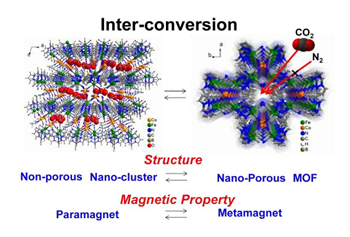
Currently, researchers are devoting great effort to the fabrication of nanoscale materials and devices. One of the current challenges is the design and synthesis of smart materials with switchable structures and functions. Using reversible polymerization and depolymerization reactions in a single crystal state, we successfully achieved a reversible transformation from a nanocluster to a coordination polymer. During the interconversion, the structural frameworks switched between a nonporous state in hexanuclear clusters and a porous state in double-zigzag chains; the magnetic behaviors switched between paramagnetic and metamagnetic, respectively. The microporous framework, which had 1D channels 1.9 × 3.6 Å in size, exhibited selective gas adsorption of H2 and CO2 over N2.
2. A Cyano-bridged CrIIICoII Ferromagnet with a Chiral Nanotubular Structure Constituted of Interlocked Single and Double Helices, Yuan-Zhu Zhang and Osamu Sato
Inorg. Chem, 49, 1271-1273 (2010).
Cover Picture !!
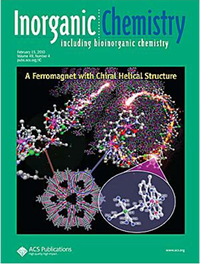
We have synthesized an unprecedented 3D cyano-bridged CrIII-CoII compound, which self-assembles into a periodically ordered, homochiral interlocking structure composed of left-handed single helices and right-handed double-helical-strands. It displays four-connected 6482 chiral networks and exhibits ferromagnetic order below 11 K. The formation of the helical structure results in the creation of helical tubular channels in the crystal.
3. An Electric Effect, Osamu Sato
Nature Chem., 2, 10-11 (2010).
Electrically tunable materials are used to construct switches and memory devices. Applying an electric field within a specific temperature to cyanometallate complexes has now triggered their charge transfer phase transition, altering their optical and magnetic properties. (News & Views)
4. Reversible Single-Crystal-to-Single-Crystal Transformation from Achiral Anti- ferromagnetic Hexanuclears to a Chiral Ferrimagnetic Double Zigzag Chain, Y.-J. Zhang, T. Liu, S. Kanegawa, O. Sato
J. Am. Chem. Soc., 131 7942–7943 (2009).
Highlighted in Nature Asia Materials Website, 31 August (2009).
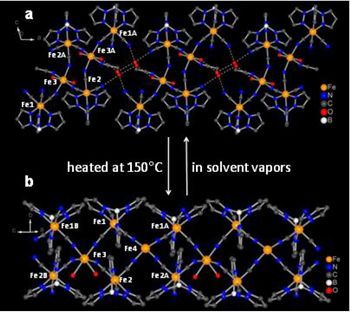
Using solid state topotactic reactions with an exploitation of directional hydrogen bonding, we established a reversible single-crystal-to-single-crystal transformation from hexanuclear clusters to a one-dimensional double-zigzag chain. With the reversible polymerization, the chirality and magnetic interactions are switched between achiral and chiral, and between antiferromagnetic in hexanuclear clusters and ferrimagnetic in chains, respectively. This study provides a novel example of reversible polymerization with switchable chirality and magnetic properties.
5. Structural Color Films with Lotus Effects, Superhydrophilicity, and Tunable Stop-Bands Sato, O., Kubo, S. Gu, Z.Z.
Acc. Chem. Res.. 42, 1-10 (2009).
6th!! : Top 20 most downloaded articles for the previous month (Nov.2008).
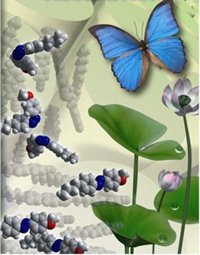
The structural blue color of a Morpho butterfly originates from the diffraction of light and interference effects due to the presence of the microstructures on the wing of the butterfly. Structural color on the surface of a damselfish reversibly changes between green and blue. Inspired by these creatures, we have prepared high-quality and/or functional structural color films. Moreover, we have developed several tunable structural color films. In particular, we have successfully prepared photo-tunable photonic crystals using photo-responsive azobenzene derivatives.
6. Bistability of Magnetization without Spin-Transition in a High-Spin Cobalt(II) Complex due to Angular Momentum Quenching, G. Juhász, R. Matsuda, S. Kanegawa, K. Inoue, O. Sato, K. Yoshizawa
J. Am. Chem. Soc., 131, 4560-4561 (2009).
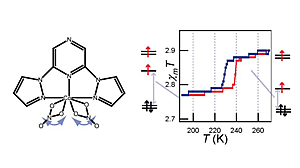
A new approach to control the magnetic susceptibility through orbital quenching of angular momentum, instead of controlling their spin state, was proposed. Functional materials with ability to abruptly change magnetic properties as a result of external perturbation have attracted great attention. The change of spin is responsible for the control of magnetic properties. However, magnetic susceptibility of transition metal compounds can also contain a non-vanishing contribution of orbital multiplicity. We found that a Co complex exhibits a bistability in orbital angular momentum connected to a phase transition that distorts the ligand field around the cobalt.
7. A Spin-Crossover Cluster of Iron(II) Exhibiting a Mixed-Spin Structure and Synergy between Spin Transition and Magnetic Interaction, D. Y. Wu, O. Sato, Y. Einaga, C.-Y. Duan,
Angew. Chem. Int. Ed., 48, 1475-1478 (2009).
Cover Picture !!
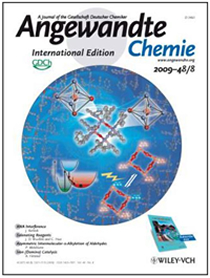
An FeII4 square was prepared by self-assembly and exhibits both thermally induced and photoinduced spin crossover from a system with four high-spin (HS) centers to one with two high-spin and two low-spin (LS) centers. The spin-crossover sites are located on the same side of the square. Because FeII spin crossover sites were bridged by a single oxygen atom, synergy between magnetic interaction and spin transition was observed. LIESST revealed a form of synergy between the light-induced excited spin state trapping and magnetic interaction.
8. CoII Molecular Square with Single-Molecule Magnet Properties Dayu Wu, Dong Guo, You Song, Wei Huang, Chunying Duan, Qingjin Meng, O. Sato
Inorg. Chem. 47, 854-860 (2009).
12th !! : Top 20 most downloaded articles over the last 12 months (Mar. 2009)
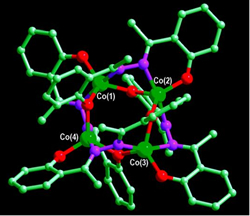
A new tetranuclear cobalt(II) molecular square has been designed for single-molecule magnets (SMMs) with high anisotropy barriers. The overall intramolecular ferromagnetic coupling at low temperature combined with the slow relaxation at static zero fields suggests a SMM behavior. ZFCM and FCM at 10 Oe illustrate the nonreversibility and bifurcation below 4.5 K. The deviations of magnetization from the saturated value in strong applied fields demonstrate the participation of low-lying excited states. The peaks of the out-of-phase signals are observed corresponding to coincidence of the applied ac field oscillation frequency with the relaxation rate.
9. Photo-Induced Spin Transition of Iron(III) Compounds with - Intermolecular Interactions
S. Hayami, K. Hiki, T. Kawahara, Y. Maeda, D. Urakami, K. Inoue, M. Ohama, S. Kawata, O. Sato
Chem. Eur. J.. 15, 3497-3508 (2009).
Cover Picture !! & VIP (Very Important Paper) !!
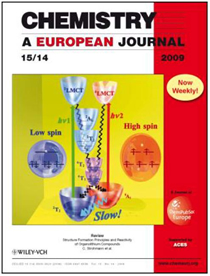
Introduction of strong intermolecular interactions leads to the observation of the LIESST effect even for iron(III) spin-crossover (SCO) compounds. For LIESST iron(III) compounds, both stretching and bending modes are considered in the reaction coordinate diagram. The picture depicts the LIESST mechanism in the reaction coordinate diagram considering both stretching and bending modes for SCO iron(III) compounds.
10. Evidence of the Chemical Uniaxial Strain Effect on Electrical Conductivity in the Spin-Crossover Conducting Molecular System: [FeIII(qnal)2][Pd(dmit)2]5·Acetone, K. Takahashi, H.-B. Cui, Y. Okano, H. Kobayashi, H. Mori, H. Tajima, Y. Einaga, O. Sato
J. Am. Chem. Soc., 130, 6688–6689 (2008).
A novel spin-crossover molecular conductor, [Fe(qnal)2] [Pd(dmit)2]5・acetone, was prepared and characterized. The crystal structural analyses of both the low- and high-temperature phases revealed that the supramolecular pi-pi interactions between the spin-crossover Fe(qnal)2 cations as well as the cation contraction play an important role in the uniaxial lattice deformation which will modulate the electrical conductivity of the conducting Pd(dmit)2 layer.
11. Control of Magnetic Properties through External Stimuli, O. Sato, J. Tao, Y. Z. Zhang,
Angew. Chem. Int. Ed. Engl. 46, 2152-2187 (2007).
20th!! : Top 25 most cited articles published in Angew. Chem 2007-2008.
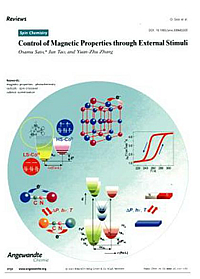
The behavior of certain magnetic materials can be controlled by external stimuli such as temperature, light, and pressure. Typical examples of such switchable materials are valence-tautomeric compounds, molecular photomagnets, and spin-crossover complexes, which could find application in memory devices or optical switches.
12. Photoinduced Valence Tautomerism in Co Compounds, O. Sato, A.L. Cui, R. Matsuda, J. Tao, S. Hayami,
Acc. Chem. Res. 40, 361-369 (2007).
13. Coexistence of Magnetization Relaxation and Dielectric Relaxation in a Single-Chain Magnet Yue-Ling Bai, Jun Tao, Wolfgang Wernsdorfer, O. Sato, Rong-Bin Huang, and Lan-Sun Zheng
J. Am. Chem. Soc. 128, 16428-16429 (2006).
14. Photochemical switching behavior of azofunctionalized polymer liquid crystal/SiO2 composite photonic crystal M. Moritsugu, S. N. Kim, T. Ogata, T. Nonaka, S. Kurihara S. Kubo, H. Segawa, O.Sato
Apply. Phys. Lett,. 89, 153131 (2006).
15. Valence tautomeric transitions with thermal hysteresis around room temperature and photoinduced effects observed in a cobalt-tetraoxolene complex J. Tao, H. Maruyama, O.Sato
J. Am. Chem. Soc. 128, 1790-1791 (2006).
16. [MnIII(salen)])6[FeIII(bpmb)(CN)2])6·7H)2O: a Unique Cyanide-Bridged Nanosized Molecular Wheel Z.-H. Ni, H.-Z. Kou, L.-F. Zhang, C. Ge, A.-L. Cui, R.-J. Wang, Y.-D. Li, O.Sato
Angew. Chem. Int. Ed., 44, 7742-7745 (2005).
17. Observation of the Anisotropic Photoinduced Magnetization Effect in Co-Fe Prussian Blue Thin Films Fabricated by Using the Clay Langmuir-Blodgett Films as a Template T. Yamamoto, Y. Umemura, O.Sato , Y. Einaga
J. Am. Chem. Soc., 127, 16065-16073 (2005).
18. Photoinduced Phase Transition in an Iron(II) Spin-crossover Complex with a N3O3 Macrocyclic Ligand H.-W. Liu A. Fujishima, O. Sato
Apply. Phys. Lett. 86, 122511 (2005).







